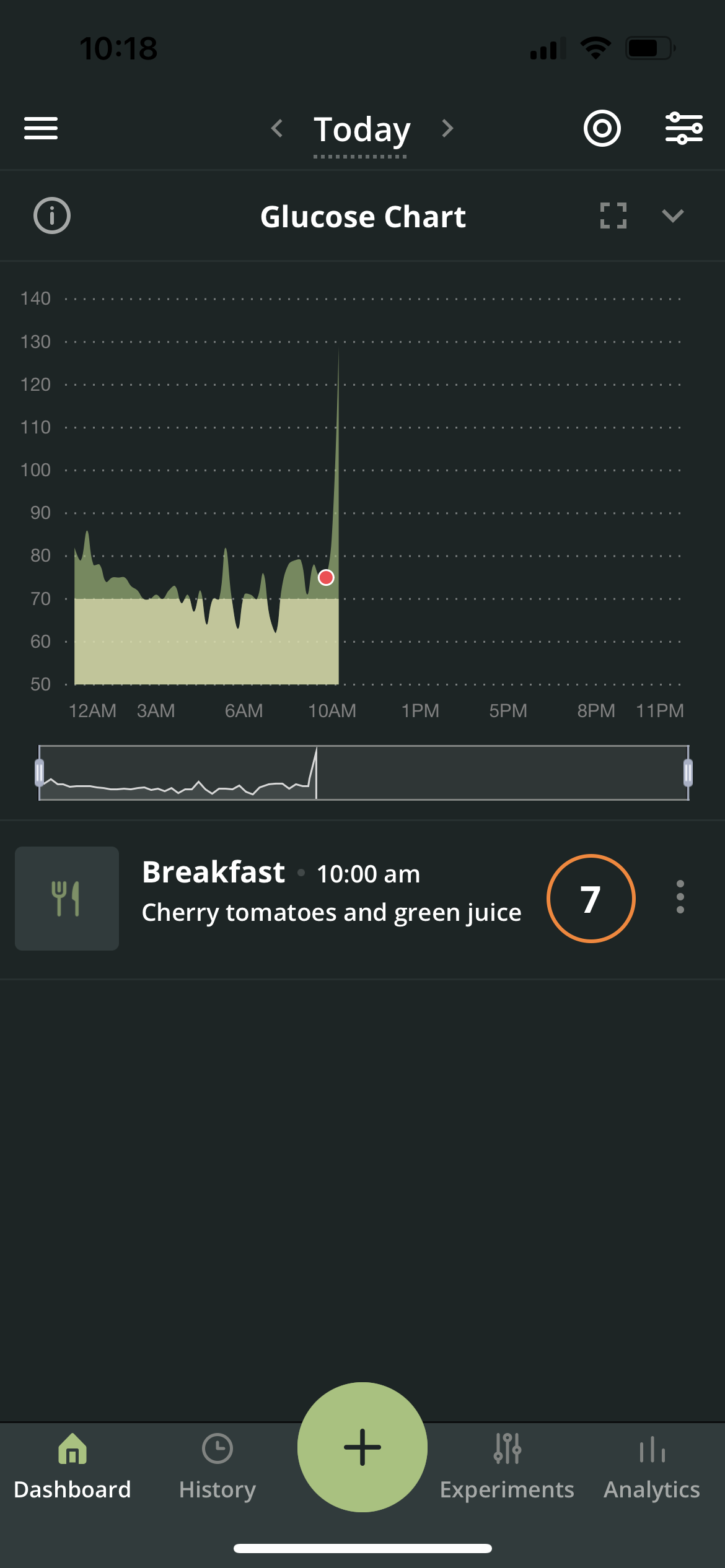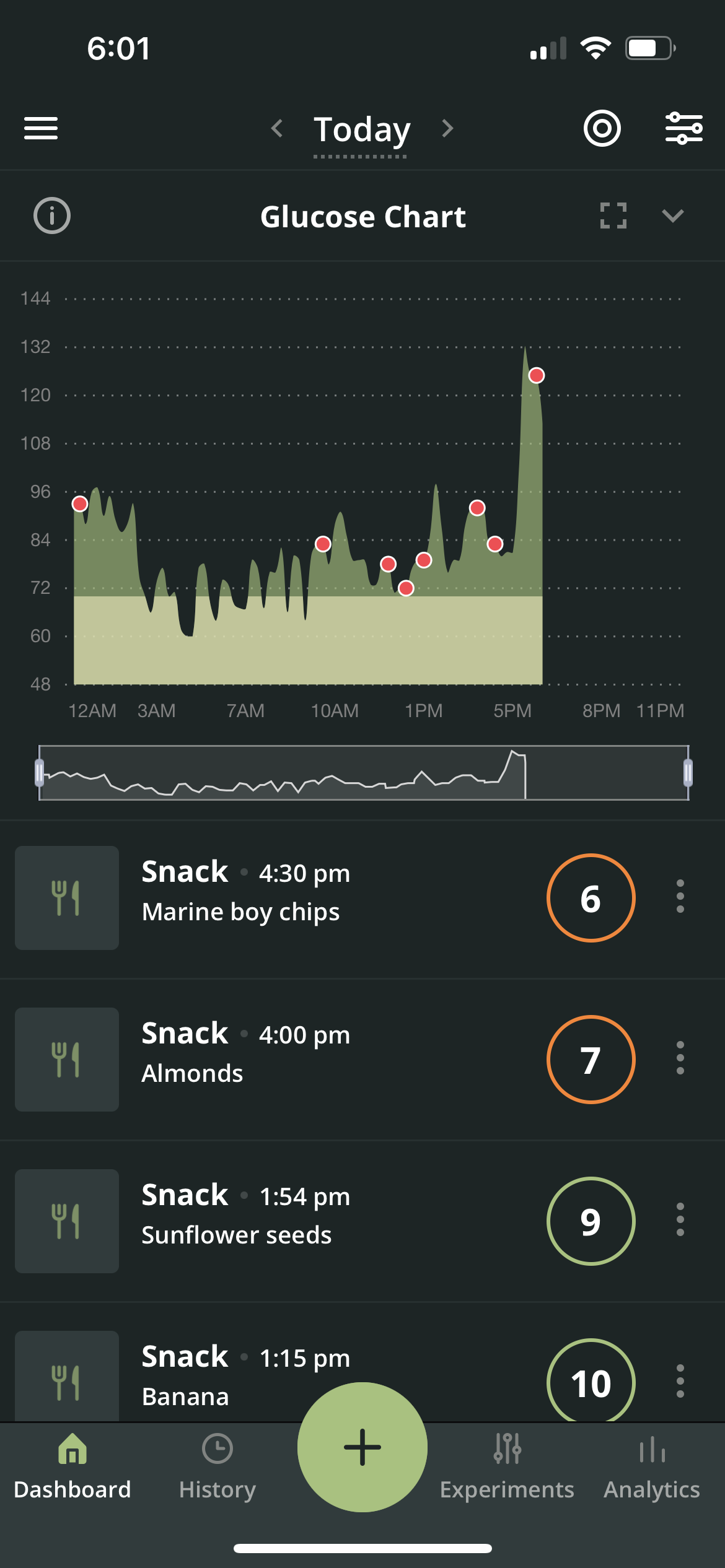Measuring my glucose for a month
I wore this continuous glucose monitor on the back of my arm for a month.
I’ve never written about nutrition much before, but it’s a passion of mine. In the last few years, I’ve made an active effort to be intentional about what I eat, and learn about nutrition from experts like Michael Pollan and Pick Up Limes. I’ve also casually tried different types of diets (Whole 30, paleo, intermittent fasting, plant-based, low-carb) but never went as far to track everything I ate.
One of my new year’s resolutions this year was to learn about my body from a physiological perspective, so in January, I tried out Nutrisense’s CGM (continuous glucose monitor) program. There was a lot I didn’t know about glucose (and there’s still a lot I don’t know) but over the course of these 28 days, I learned just how much sugar is in everything we eat, and how it affects my own body. Although I’m not technically pre-diabetic, as Americans, aren’t we all pre-pre-diabetic?
Wearing a monitor
Wearing the CGM device wasn’t an issue. It’s simple enough to apply on your own, and even though I felt a little something jabbing into my arm for the first 2 days, I forgot about it afterward. The only thing I had to do was be careful about yanking off clothes with straps that can get caught, and once in a while, pass on a weird pose in yoga class that involved pressing my body weight against it.
Tracking everything I ate
Okay, this part actually took effort. Because the app required me to input everything I ate, taking the time to do so before every meal or snack was a bit more onerous. After I ate, I would have to scan the back of my arm to log my device measurements onto the app. Because it made me pause before eating, it did make me more intentional about eating. For example, I was too lazy to record popcorn, so I didn’t reach for the popcorn.
Fresh juice shot up my glucose.
So did these seaweed snacks for some reason.
Chinese food is peak carbs!
Watching the app trying to visually guess what Chinese abalone dish I was eating was also entertaining.
What I observed
Things that spike my glucose: banana, chips, green juice, sticky rice, fruit juices and teas, even dried mango. This may be obvious from a scientific perspective (fruit have carbs!), but personal habit-wise I never thought eating fruit would be an issue. A single banana for breakfast wasn’t going to cut it. My dietician recommended eating protein and fats with your carbs to slow down the digestion and absorption of glucose. For example, if I eat an egg or some nuts before my banana, I don’t spike.
Common sources of naturally occurring carbs include fruit (apples, oranges, etc), starchy vegetables (potatoes, corn, pumpkin, peas, etc), diary (milk, yogurt), grains (bread, flour, oats, pasta, etc), and legumes (beans, lentils, etc). Bodies are different and can handle carbs differently.
Foods that triggered a long recovery: dimsum and Asian food (noodles, fried rice, congee, ramen, sushi rolls, mango sticky rice). I was traveling in Asia for half of January, and there were times we inhaled our meal after a long starvation period. The tip here is to eat veggies and protein first before the carbs.
Eating food slower also helps. I noticed long dimsum meals that were served course by course didn’t trigger many spikes. But drinking freshly blended green juice did, because all that liquid glulcose is super concentrated and consumed quickly.
I feel the effects of my blood sugar dropping after eating dessert after lunch. Just a small slice of cake will do it for me 😬
I stopped craving dessert after dinner. Usually I go for a little ice cream or devour fruit after dinner. But now dessert doesn’t feel as satisfying, which I think is progress!
On days where I exercised, my food-induced spikes were subsided. Exercise also increases your blood sugar, but in a good way.
Don’t eat right before a cardio-intensive workout. My dietitian recommended having snacks that digest more quickly (carbs) like a piece of fruit and some nuts so your body can absorb that energy quickly to fuel your workout. Pre-workout meal recommendations:
More than 1.5 hours before workout, choose proteins like meat or eggs + a veggie + a low glycemic starch + fruit
Around 1-1.5 hours before (ideal best time for a pre-workout meal), choose something easier to digest like protein powder + oats + 1 fruit + nut butter.
If 30 min before, you need something super quick and light, like a protein shake + 1 low fiber fruit
For post-workout. Cardio = higher carb to replenish glycogen you burned. Strength training = adequate protein for muscle repair.
Last but not least, post-prandial walks are key! Especially if you had carbs, digest with an after-meal walk.
After wearing the monitor for two weeks and tracking my eating on a daily basis, I pretty much learned what worked for me. My glucose never spiked above 140mg/dL but it definitely came close a couple of times. Nutrition is one of those subjects I never really learned growing up, but I’m excited to continue learning.












I just hit my one year anniversary of climbing. Here’s that story, in a short film.